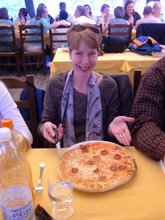Are you suffering from a New Year’s resolution hangover? After binge-writing a list of the many and assorted improvements and experiences I want in 2010, I do feel your pain. For self-improvement junkies like me, the prospect of mapping out a life that will be perfect at some future point in time is like cocaine to a crack-head. I realize this, yet I still engage in the insanity.
Here’s how we think: After I give up sugar, grow my own vegetables, purge and organize every closet in my house, make slipcovers for my office furniture, limit the amount of time I spend online, quit judging other people, make cases for my yoga mats, make eye pillows for my students and classmates, read several books each week, play golf this summer, commit 30 minutes a day to prayer and meditation, make a purse out of some old neckties, clean the laundry room and garage, make roman shades for my patio doors, e-mail at least one friend a day and see at least two lifeline friends each month, make 15 minutes a day to pick up the house, make 10 minutes a day to file incoming paperwork, do at least one thing each day in service to others, deepen my knowledge of online marketing, take a class on teaching yoga for kids, finish the taxes by February 15, organize all my loose recipes into notebooks, purge and label all the files in our file cabinets, do a little housework at least two evening a week, continue my fitness schedule of four workouts each week—AFTER I do all this (while holding down two—no wait a minute—three part-time jobs) my life will, of course be perfect, worthwhile, satisfying. I’ll be 95-years-old. But I’ll be—well—satisfied. You get the drift.
Stephen Cope’s book,
The Wisdom of Yoga, sheds yogic light on this crazy cycle. It involves three afflictions of the human mind that are the source of nearly all suffering.
- Cravings. Our tendency to lean forward into the next fantasized moment in the future is called rãga (clinging, attachment, attraction, hunger, ambition).
- Aversions. Some resolutions are about stopping things we know are bad for us. Yoga masters might have classified this as dvesha —aversion to the experience. This is what tells us to stop, leave, or look backward to a previous state of comfort.
- Delusions. Finally, we may completely disappear from the moment by creating a delusion, a mind state known as moha. We do this by creating a false picture of reality based on how life should be (which is always different than the way it actually is) or through complete avoidance. (e.g. Don’t make me look!)
Cope’s book is drawn from the Yoga Sutras, a brilliant piece of writing that explores man’s spiritual and psychological nature. He says we crave accomplishments and experiences (
rãga), run away from things (
dvesha), or create delusions for ourselves (
moha) because we don’t fully experience our lives as they already are (
avidyã).
Is all longing afflicted? All aversion afflicted? All delusion afflicted? Of course not! There are times that these things serve us well. Cope’s book maps the territory between the healthy and the afflicted state of mind. What makes a mindset afflictive?
- Afflicted mindsets are disturbing. We feel uncomfortable and unbalanced in our very being.
- Afflicted mindsets are obscuring. This state makes things worse or better than they really are. Either way, our perceptions aren’t true or accurate. We overrate some things. Or we fail to notice the bad effects of others.
- Afflicted mindsets are separative. Something is separating us from our happiness—love, material things, success, achievements. Once we have those things, we’ll feel complete. This is reflected in the life of King Solomon who pursued pleasure, success, love, purity, peace, wisdom--everything known to man. In the end, he said the whole purpose of man was to keep God’s commandments—to commune with God.
Yogis believe that we penetrate these layers of afflicted mindsets through meditation. In meditation, we access a more luminous part of our mind that is already acquainted with happiness as a natural state. Having freed ourselves from these afflictions, we make truly conscious choices—not patterned ones that are made less out of choice than conditioning.
Although this blog does not usually cover matters of religion, as a practicing Christian, I feel duty bound to say this much: If you want a book that teaches you how to live a more peaceful life on earth, study the Yoga Sutras. If you want a book that teaches you how to live a more peaceful life on earth
and for all eternity, study the Bible.
In my opinion, the Yoga Sutras echo God’s wisdom in many ways, but you might find a few errors and omissions when it comes to peace that leads to heaven. To the Christian, happiness on earth is far less important than eternal peace with God. Christians believe that meditation, prayer, and godly actions give everyone a shot at the real prize--eternal peace.
If there’s a comparison to be made between the two books, here’s my best (but oversimplified) shot at it: the Bible tells us exactly what God wants us to do to be truly at peace with Him—not
just at peace with ourselves. (We’ve already acknowledged that the latter isn’t quite enough because we sometimes lie to ourselves.) The Yoga Sutras reveal some manmade techniques we can use to work our way through some of the more difficult aspects of living to that standard.
If you binged on making resolutions for 2010, Cope’s book might encourage you to look more realistically at your aspirations as insight about yourself. The real value of New Year’s resolutions may be what they reveal about our motivations and our state of mind.
The Wisdom of Yoga provides an accessible way to see the Sutras applied in everyday life.










